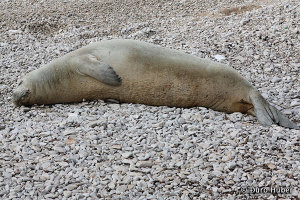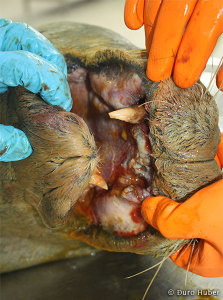by Prof. Dr Đuro Huber, Biology Department, Veterinary Faculty, Zagreb, Croatia
 The individual concerned was photographed for the first time on 08 March 2009 by the Monk Seal Group (Jasna Antolović, chair) in the Nature Park Kamenjak at the tip of the Istria peninsula. Confirmed sightings of the monk seal in the area started already in 2004. However, at that time the animal did not have the distinguishable scars on the base of the neck and the base of the hind left flipper. It can be stated that this animal stayed in the area at least for five years and probably almost for 11 years. Automatic cameras pictured her on many occasions in the meantime, but she was also seen several times around the island of Cres, as well.
The individual concerned was photographed for the first time on 08 March 2009 by the Monk Seal Group (Jasna Antolović, chair) in the Nature Park Kamenjak at the tip of the Istria peninsula. Confirmed sightings of the monk seal in the area started already in 2004. However, at that time the animal did not have the distinguishable scars on the base of the neck and the base of the hind left flipper. It can be stated that this animal stayed in the area at least for five years and probably almost for 11 years. Automatic cameras pictured her on many occasions in the meantime, but she was also seen several times around the island of Cres, as well.
Since the winter of 2013/14 she was frequently found resting on public beaches not exhibiting fear of people. On 21 February 2014 Đuro Huber observed and photographed her in a perfect physical condition sleeping on a beach and breathing 6 times per minute. Some foamy yellow liquid was seen coming out of her nose on several occasions. Jasna Antolović once provided a bacteriological test of the liquid and Pseudomonas aeruginosa bacteria were determined. The seal continued to use beaches near urban areas through summer 2014 when the same beaches were crowded with people. Even close proximity approaches by humans on the shore and in the water were tolerated.
In early June a loss of body mass was noticed which continued progressively until death. It was estimated that ultimately she lost half of her body mass. During her last several weeks, a general weakness was remarked, although she continued the routine of going to swim and coming back to various beaches. In the last two days some blood issuing from her mouth was observed when she entered the water. As a test, a fish and squid were offered to her when while swimming but no interest was shown. On the day of her death (25 August 2014) she entered the water from the Mrtvi Puć beach (where she had spent the night) at 09.30 and started to swim in a south-westerly direction. At 13.30 she was found dead on the rocky shore just out of the reach of waves in Velika Draga (N 44º50.689᾽ E 13º58.831᾽). The body was transferred to the Veterinary Faculty in Zagreb the same day and the necropsy was performed the next morning (26 August 2014) from 09.00 until 12.00.
 External examination revealed an emaciated body with parts of the skeleton visible under the skin. The body mass was 115 kg and the total length, 234 cm. All measurements and samples were taken. The only teeth she had remaining were one upper and one lower canine. Internal examination revealed total loss of fat tissue and very dark organs full of blood. The digestive tract was empty with at least 10 parasitic tapeworms. The right of the heart was dilated, and the abdominal vein was oversized with blood stasis. Some yellow foamy liquid was found in the trachea and bronchi. The lungs had numerous disseminated nodules full of purulent content. The diagnosis of the cause of death was chronic pneumonia.
External examination revealed an emaciated body with parts of the skeleton visible under the skin. The body mass was 115 kg and the total length, 234 cm. All measurements and samples were taken. The only teeth she had remaining were one upper and one lower canine. Internal examination revealed total loss of fat tissue and very dark organs full of blood. The digestive tract was empty with at least 10 parasitic tapeworms. The right of the heart was dilated, and the abdominal vein was oversized with blood stasis. Some yellow foamy liquid was found in the trachea and bronchi. The lungs had numerous disseminated nodules full of purulent content. The diagnosis of the cause of death was chronic pneumonia.
The whole body of the animal will be taken by the Croatian Museum of Natural History, where the plan is to prepare the skeleton and the mount.
NOTE: The pathologist in charge was Dr Ivan-Conrado Šoštarić-Zuckermann. This is an unofficial orientation report.
